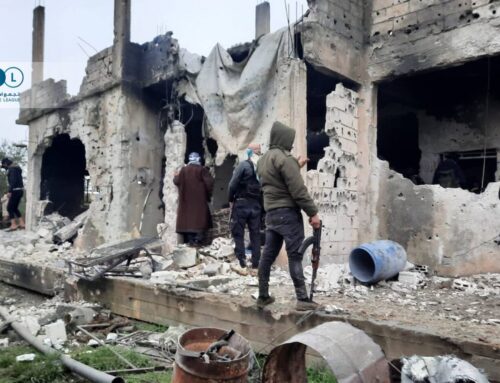As airstrikes rain on Jobar, battle moves underground
September 11, 2014 The Assad regime has begun a series […]
11 September 2014
September 11, 2014
The Assad regime has begun a series of air strikes nearly every day on the rebel-controlled district of Jobar, situated just east of the Abbasid Square in central Damascus. Jobar is the closest rebel-held area to Damascus and serves as a gateway into East Ghouta, the FSA stronghold east of Damascus city that serves as the epicenter of opposition power in the region.
While the regime’s aerial strikes on the neighborhood attract most of the headlines, long-time observers of Jobar know that the real battle is taking place underground.
Because of their close proximity to Damascus, rebels in Jobar have been burrowing their way towards it over the course of the war rather than face the well-positioned snipers above ground. The regime has responded in kind, by building their own tunnels to protect themselves and attack the opposition, resulting in a cat-and-mouse game as regime soldiers and rebels try to outwit each with surprise attacks.
Both the rebels and the regime are rumored to have enlisted foreign expertise in the matter, with the Palestinian group Hamas reportedly teaching the Syrian opposition fighters how to tunnel with Hezbollah, staunch supporters of Assad, defending against them.
In the latest regime attack on Jobar, the Syrian army has made a concerted effort to eliminate the threat of rebel tunnels, destroying them with well-placed bombs, reports pro-regime news agency Al-Alam.
The Syrian Army has had to learn from its mishaps in its response to underground rebel attacks, said Yousef Abu Daqqa, a spokesperson for the pro-opposition Union of Syrian Revolution LCC. The Union of Syrian Revolution LCC is a grassroots umbrella organization that aims to strengthen Syrian civil society and overthrow the Assad government.
The opposition discovered the regime was operating underground six months ago when army forces “made a mistake and blew up one of its own buildings,” a Damascus-based activist, who also works as a photographer for Reuters, tells Syria Direct’s Mohammad al-Haj Ali.
“We discovered the tunnel led to the middle of Jobar.”
Q: Why do you think the regime is digging tunnels around Jobar?
The purpose of the tunnels is to bomb buildings that the FSA uses as strongholds and to launch attacks on them.

Q: Did the regime dig tunnels like this before?
Yes, but the regime doesn’t have much experience in digging tunnels. Six months ago in Jobar, the regime made a mistake and blew up one of its own buildings, killing its soldiers.
Q: How were the tunnels discovered?
They were discovered by coincidence: we basically knew about them [before], but didn’t have all the details. When we first raided the [regime] buildings we found a tunnel in one of the basements. In the beginning we didn’t know where the tunnel led to, then we discovered that it was heading towards the center of Jobar.
Q: How were the tunnels dug?
According to an eyewitness, the regime had transferred prisoners to dig there. We didn’t find any machines, but we know they were using something advanced to dig because the diameter of the tunnel was too big for a human to dig it [by himself].
Q: Where were the tunnels located?
These tunnels were located in the buildings that we raided near the Abbasid Soccer Stadium in [central] Damascus. The regime sometimes digs tunnels between its headquarters [in Damascus].
Q: What services did the tunnels have inside?
The regime installed electric lamps in the tunnels and the tunnels were almost two meters high.
For more from Syria Direct, like us on Facebook or follow us on Twitter.







